SUBARU WRX 2020 Quick Guide
Manufacturer: SUBARU, Model Year: 2020, Model line: WRX, Model: SUBARU WRX 2020Pages: 44, PDF Size: 15.19 MB
Page 21 of 44
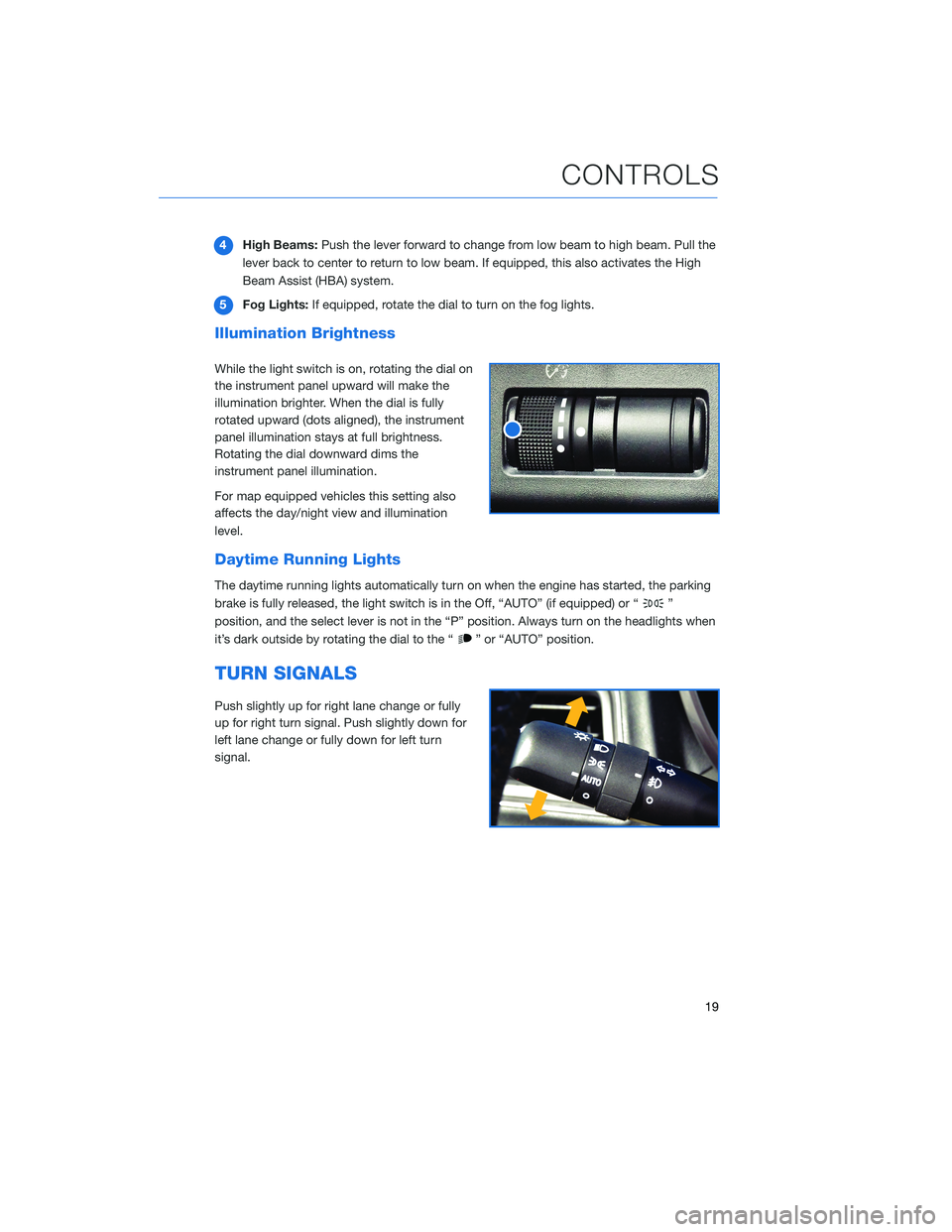
4High Beams:Push the lever forward to change from low beam to high beam. Pull the
lever back to center to return to low beam. If equipped, this also activates the High
Beam Assist (HBA) system.
5Fog Lights:If equipped, rotate the dial to turn on the fog lights.
Illumination Brightness
While the light switch is on, rotating the dial on
the instrument panel upward will make the
illumination brighter. When the dial is fully
rotated upward (dots aligned), the instrument
panel illumination stays at full brightness.
Rotating the dial downward dims the
instrument panel illumination.
For map equipped vehicles this setting also
affects the day/night view and illumination
level.
Daytime Running Lights
The daytime running lights automatically turn on when the engine has started, the parking
brake is fully released, the light switch is in the Off, “AUTO” (if equipped) or “
”
position, and the select lever is not in the “P” position. Always turn on the headlights when
it’s dark outside by rotating the dial to the “
” or “AUTO” position.
TURN SIGNALS
Push slightly up for right lane change or fully
up for right turn signal. Push slightly down for
left lane change or fully down for left turn
signal.
CONTROLS
19
Page 22 of 44
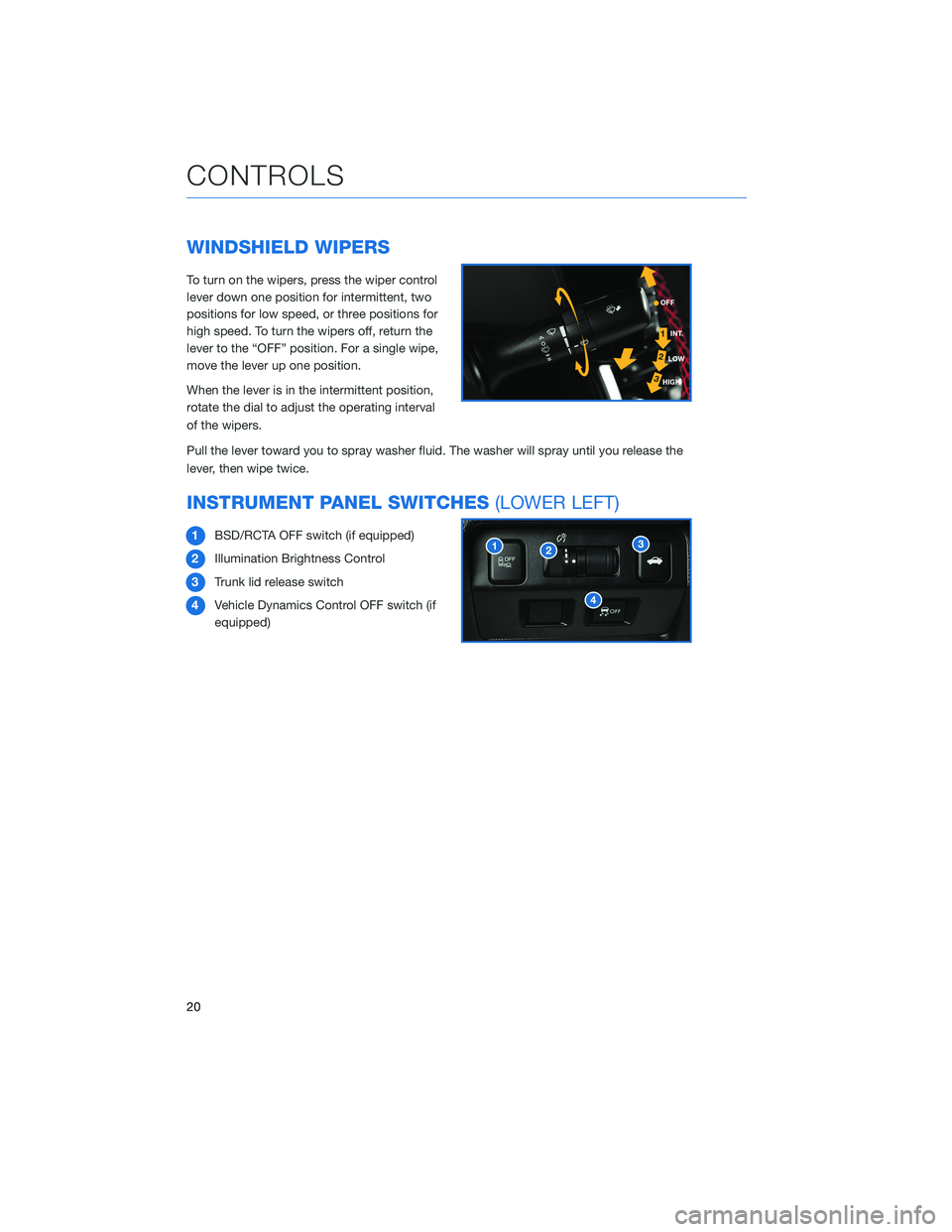
WINDSHIELD WIPERS
To turn on the wipers, press the wiper control
lever down one position for intermittent, two
positions for low speed, or three positions for
high speed. To turn the wipers off, return the
lever to the “OFF” position. For a single wipe,
move the lever up one position.
When the lever is in the intermittent position,
rotate the dial to adjust the operating interval
of the wipers.
Pull the lever toward you to spray washer fluid. The washer will spray until you release the
lever, then wipe twice.
INSTRUMENT PANEL SWITCHES(LOWER LEFT)
1BSD/RCTA OFF switch (if equipped)
2Illumination Brightness Control
3Trunk lid release switch
4Vehicle Dynamics Control OFF switch (if
equipped)
CONTROLS
20
Page 23 of 44
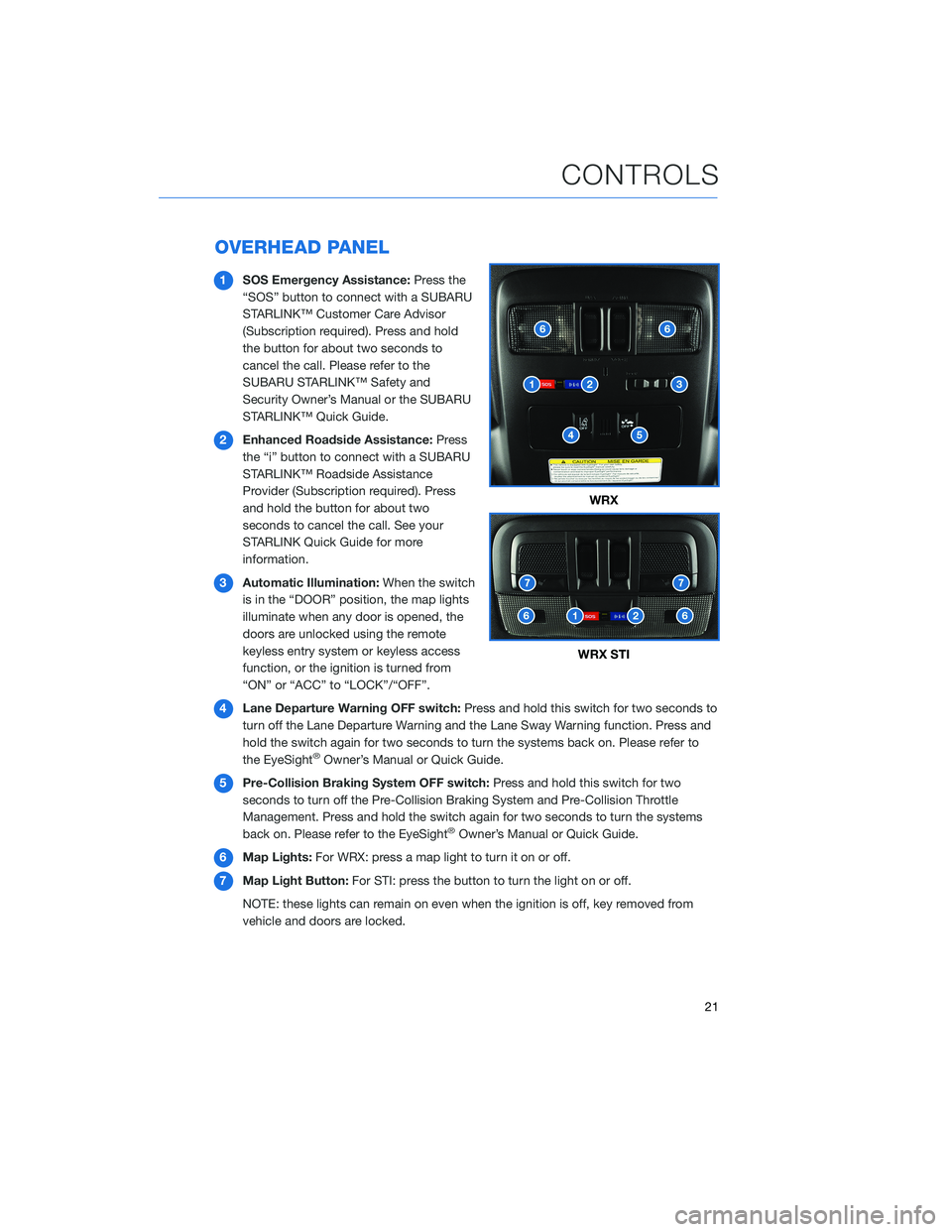
OVERHEAD PANEL
1SOS Emergency Assistance:Press the
“SOS” button to connect with a SUBARU
STARLINK™ Customer Care Advisor
(Subscription required). Press and hold
the button for about two seconds to
cancel the call. Please refer to the
SUBARU STARLINK™ Safety and
Security Owner’s Manual or the SUBARU
STARLINK™ Quick Guide.
2Enhanced Roadside Assistance:Press
the “i” button to connect with a SUBARU
STARLINK™ Roadside Assistance
Provider (Subscription required). Press
and hold the button for about two
seconds to cancel the call. See your
STARLINK Quick Guide for more
information.
3Automatic Illumination:When the switch
is in the “DOOR” position, the map lights
illuminate when any door is opened, the
doors are unlocked using the remote
keyless entry system or keyless access
function, or the ignition is turned from
“ON” or “ACC” to “LOCK”/“OFF”.
4Lane Departure Warning OFF switch:Press and hold this switch for two seconds to
turn off the Lane Departure Warning and the Lane Sway Warning function. Press and
hold the switch again for two seconds to turn the systems back on. Please refer to
the EyeSight
®Owner’s Manual or Quick Guide.
5Pre-Collision Braking System OFF switch:Press and hold this switch for two
seconds to turn off the Pre-Collision Braking System and Pre-Collision Throttle
Management. Press and hold the switch again for two seconds to turn the systems
back on. Please refer to the EyeSight
®Owner’s Manual or Quick Guide.
6Map Lights:For WRX: press a map light to turn it on or off.
7Map Light Button:For STI: press the button to turn the light on or off.
NOTE: these lights can remain on even when the ignition is off, key removed from
vehicle and doors are locked.
WRX
WRX STI
CONTROLS
21
Page 24 of 44
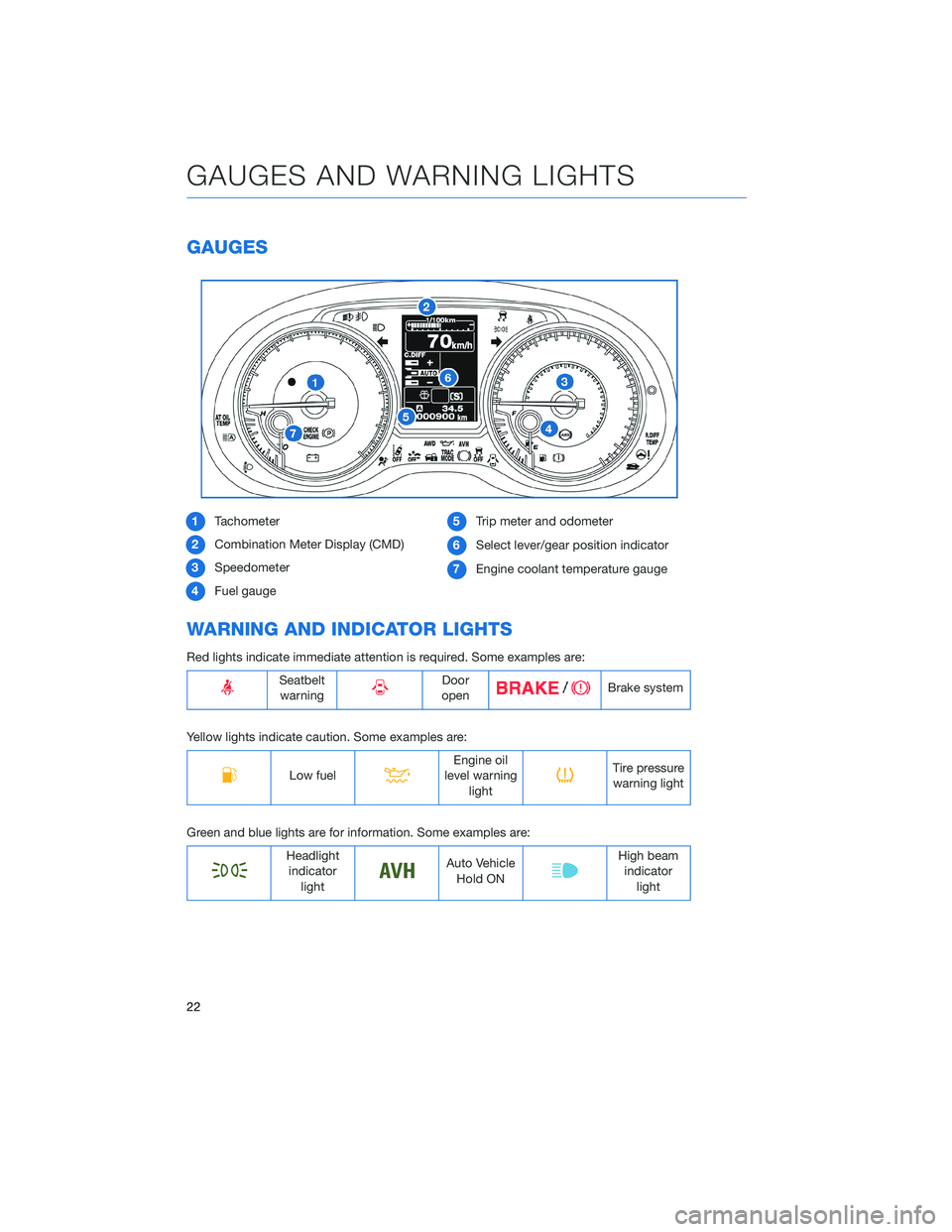
GAUGES
1Tachometer
2Combination Meter Display (CMD)
3Speedometer
4Fuel gauge5Trip meter and odometer
6Select lever/gear position indicator
7Engine coolant temperature gauge
WARNING AND INDICATOR LIGHTS
Red lights indicate immediate attention is required. Some examples are:
Seatbelt
warningDoor
openBrake system
Yellow lights indicate caution. Some examples are:
Low fuelEngine oil
level warning
lightTire pressure
warning light
Green and blue lights are for information. Some examples are:
Headlight
indicator
lightAuto Vehicle
Hold ONHigh beam
indicator
light
GAUGES AND WARNING LIGHTS
22
Page 25 of 44
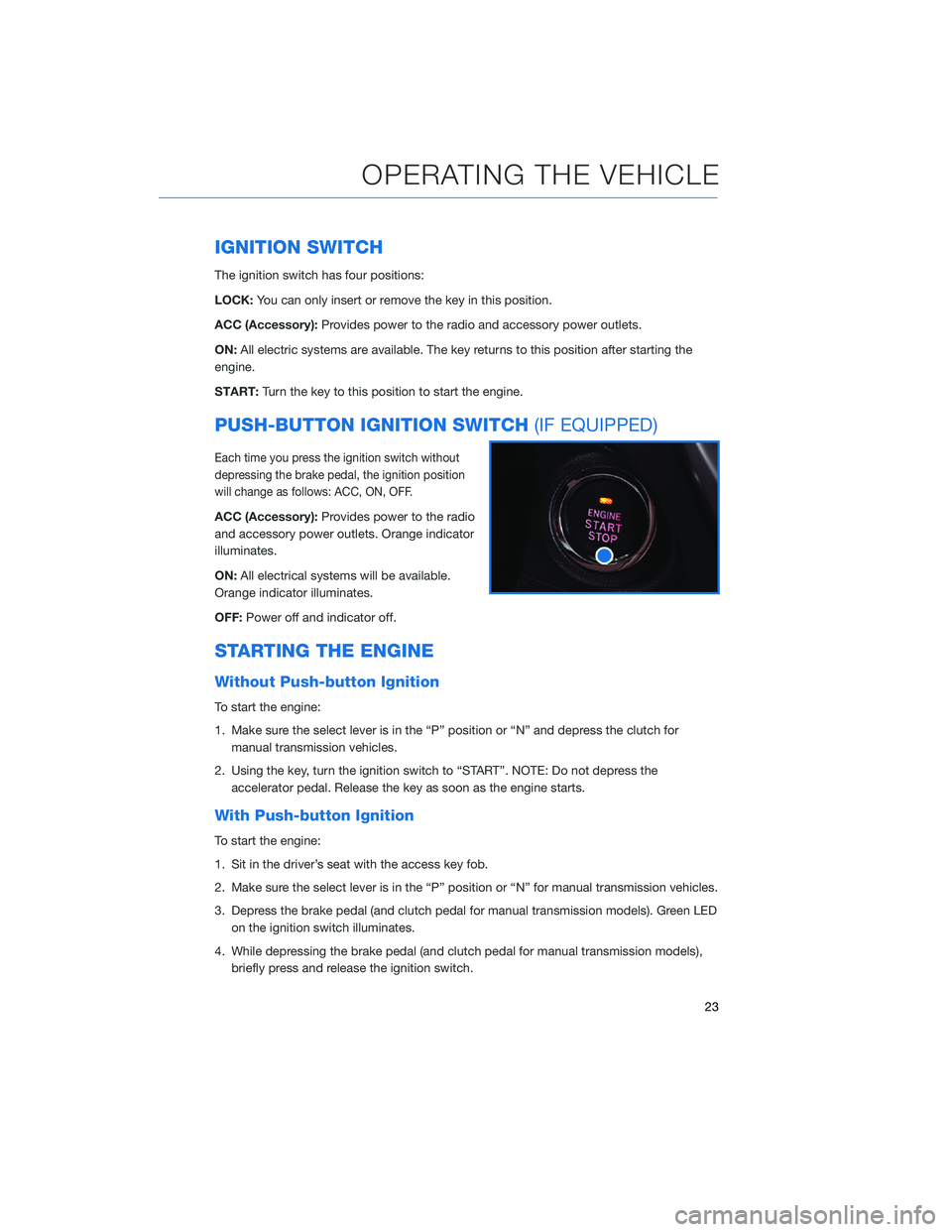
IGNITION SWITCH
The ignition switch has four positions:
LOCK:You can only insert or remove the key in this position.
ACC (Accessory):Provides power to the radio and accessory power outlets.
ON:All electric systems are available. The key returns to this position after starting the
engine.
START:Turn the key to this position to start the engine.
PUSH-BUTTON IGNITION SWITCH(IF EQUIPPED)
Each time you press the ignition switch without
depressing the brake pedal, the ignition position
will change as follows: ACC, ON, OFF.
ACC (Accessory):Provides power to the radio
and accessory power outlets. Orange indicator
illuminates.
ON:All electrical systems will be available.
Orange indicator illuminates.
OFF:Power off and indicator off.
STARTING THE ENGINE
Without Push-button Ignition
To start the engine:
1. Make sure the select lever is in the “P” position or “N” and depress the clutch for
manual transmission vehicles.
2. Using the key, turn the ignition switch to “START”. NOTE: Do not depress the
accelerator pedal. Release the key as soon as the engine starts.
With Push-button Ignition
To start the engine:
1. Sit in the driver’s seat with the access key fob.
2. Make sure the select lever is in the “P” position or “N” for manual transmission vehicles.
3. Depress the brake pedal (and clutch pedal for manual transmission models). Green LED
on the ignition switch illuminates.
4. While depressing the brake pedal (and clutch pedal for manual transmission models),
briefly press and release the ignition switch.
OPERATING THE VEHICLE
23
Page 26 of 44
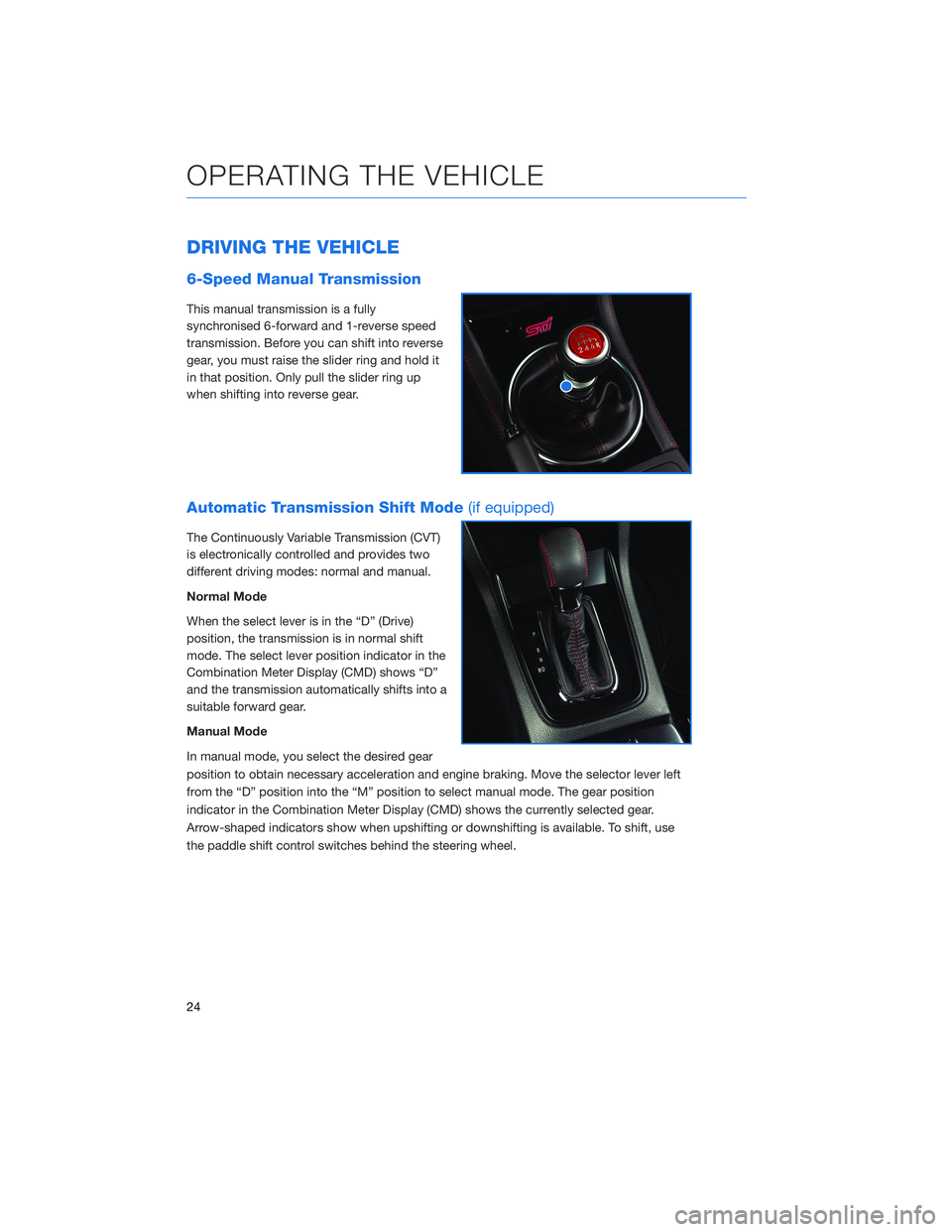
DRIVING THE VEHICLE
6-Speed Manual Transmission
This manual transmission is a fully
synchronised 6-forward and 1-reverse speed
transmission. Before you can shift into reverse
gear, you must raise the slider ring and hold it
in that position. Only pull the slider ring up
when shifting into reverse gear.
Automatic Transmission Shift Mode(if equipped)
The Continuously Variable Transmission (CVT)
is electronically controlled and provides two
different driving modes: normal and manual.
Normal Mode
When the select lever is in the “D” (Drive)
position, the transmission is in normal shift
mode. The select lever position indicator in the
Combination Meter Display (CMD) shows “D”
and the transmission automatically shifts into a
suitable forward gear.
Manual Mode
In manual mode, you select the desired gear
position to obtain necessary acceleration and engine braking. Move the selector lever left
from the “D” position into the “M” position to select manual mode. The gear position
indicator in the Combination Meter Display (CMD) shows the currently selected gear.
Arrow-shaped indicators show when upshifting or downshifting is available. To shift, use
the paddle shift control switches behind the steering wheel.
OPERATING THE VEHICLE
24
Page 27 of 44
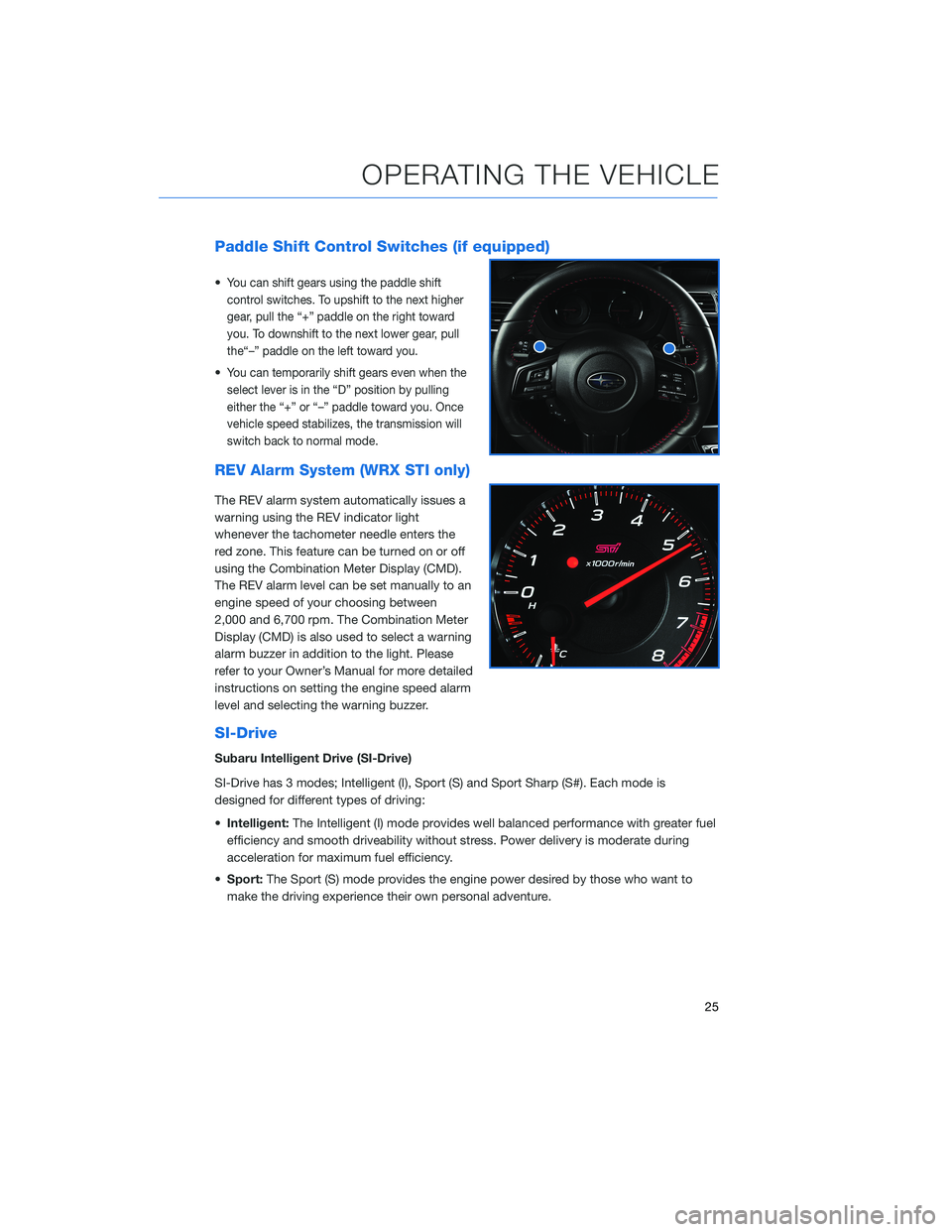
Paddle Shift Control Switches (if equipped)
•You can shift gears using the paddle shift
control switches. To upshift to the next higher
gear, pull the “+” paddle on the right toward
you. To downshift to the next lower gear, pull
the“–” paddle on the left toward you.
•You can temporarily shift gears even when the
select lever is in the “D” position by pulling
either the “+” or “–” paddle toward you. Once
vehicle speed stabilizes, the transmission will
switch back to normal mode.
REV Alarm System (WRX STI only)
The REV alarm system automatically issues a
warning using the REV indicator light
whenever the tachometer needle enters the
red zone. This feature can be turned on or off
using the Combination Meter Display (CMD).
The REV alarm level can be set manually to an
engine speed of your choosing between
2,000 and 6,700 rpm. The Combination Meter
Display (CMD) is also used to select a warning
alarm buzzer in addition to the light. Please
refer to your Owner’s Manual for more detailed
instructions on setting the engine speed alarm
level and selecting the warning buzzer.
SI-Drive
Subaru Intelligent Drive (SI-Drive)
SI-Drive has 3 modes; Intelligent (I), Sport (S) and Sport Sharp (S#). Each mode is
designed for different types of driving:
•Intelligent:The Intelligent (I) mode provides well balanced performance with greater fuel
efficiency and smooth driveability without stress. Power delivery is moderate during
acceleration for maximum fuel efficiency.
•Sport:The Sport (S) mode provides the engine power desired by those who want to
make the driving experience their own personal adventure.
OPERATING THE VEHICLE
25
Page 28 of 44
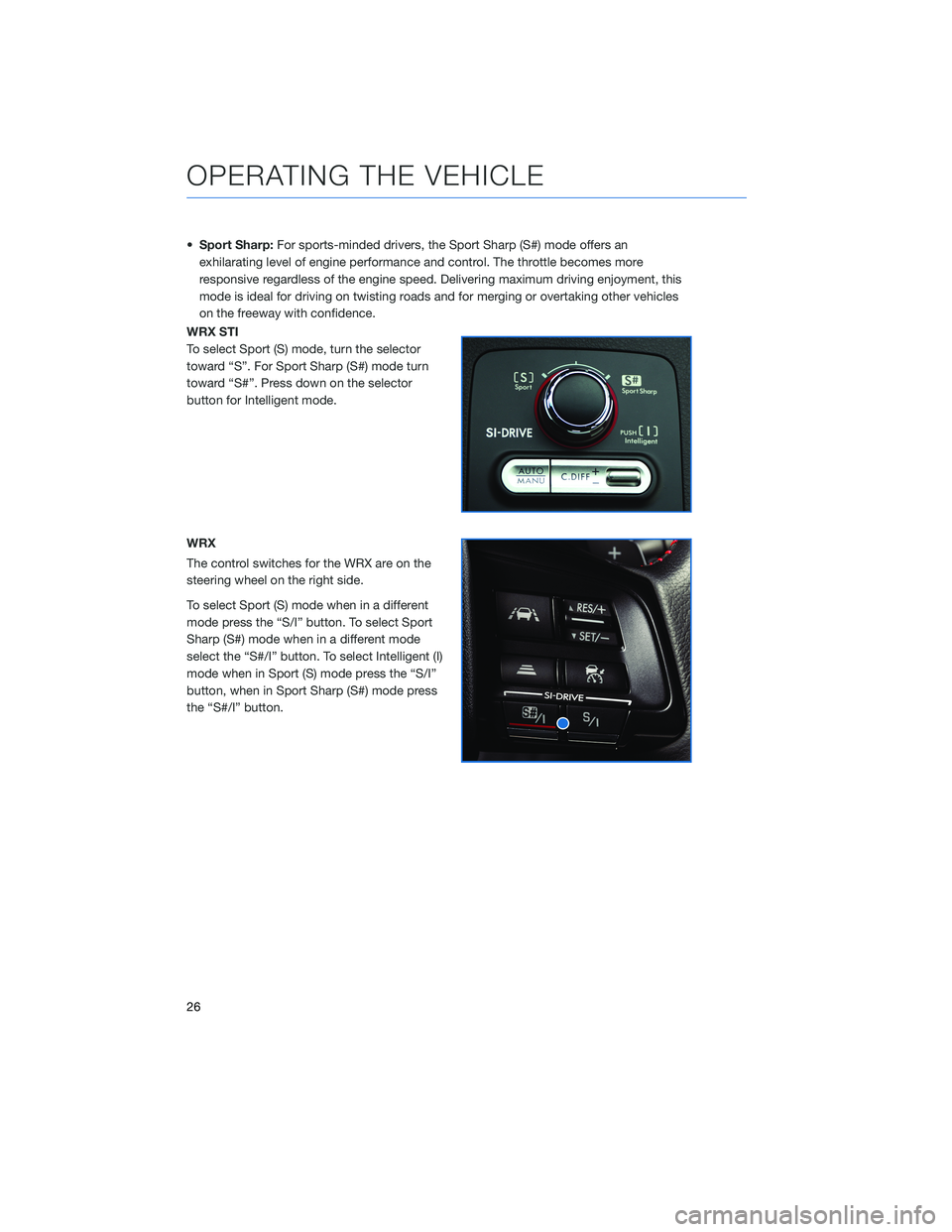
•Sport Sharp:For sports-minded drivers, the Sport Sharp (S#) mode offers an
exhilarating level of engine performance and control. The throttle becomes more
responsive regardless of the engine speed. Delivering maximum driving enjoyment, this
mode is ideal for driving on twisting roads and for merging or overtaking other vehicles
on the freeway with confidence.
WRX STI
To select Sport (S) mode, turn the selector
toward “S”. For Sport Sharp (S#) mode turn
toward “S#”. Press down on the selector
button for Intelligent mode.
WRX
The control switches for the WRX are on the
steering wheel on the right side.
To select Sport (S) mode when in a different
mode press the “S/I” button. To select Sport
Sharp (S#) mode when in a different mode
select the “S#/I” button. To select Intelligent (I)
mode when in Sport (S) mode press the “S/I”
button, when in Sport Sharp (S#) mode press
the “S#/I” button.
OPERATING THE VEHICLE
26
Page 29 of 44
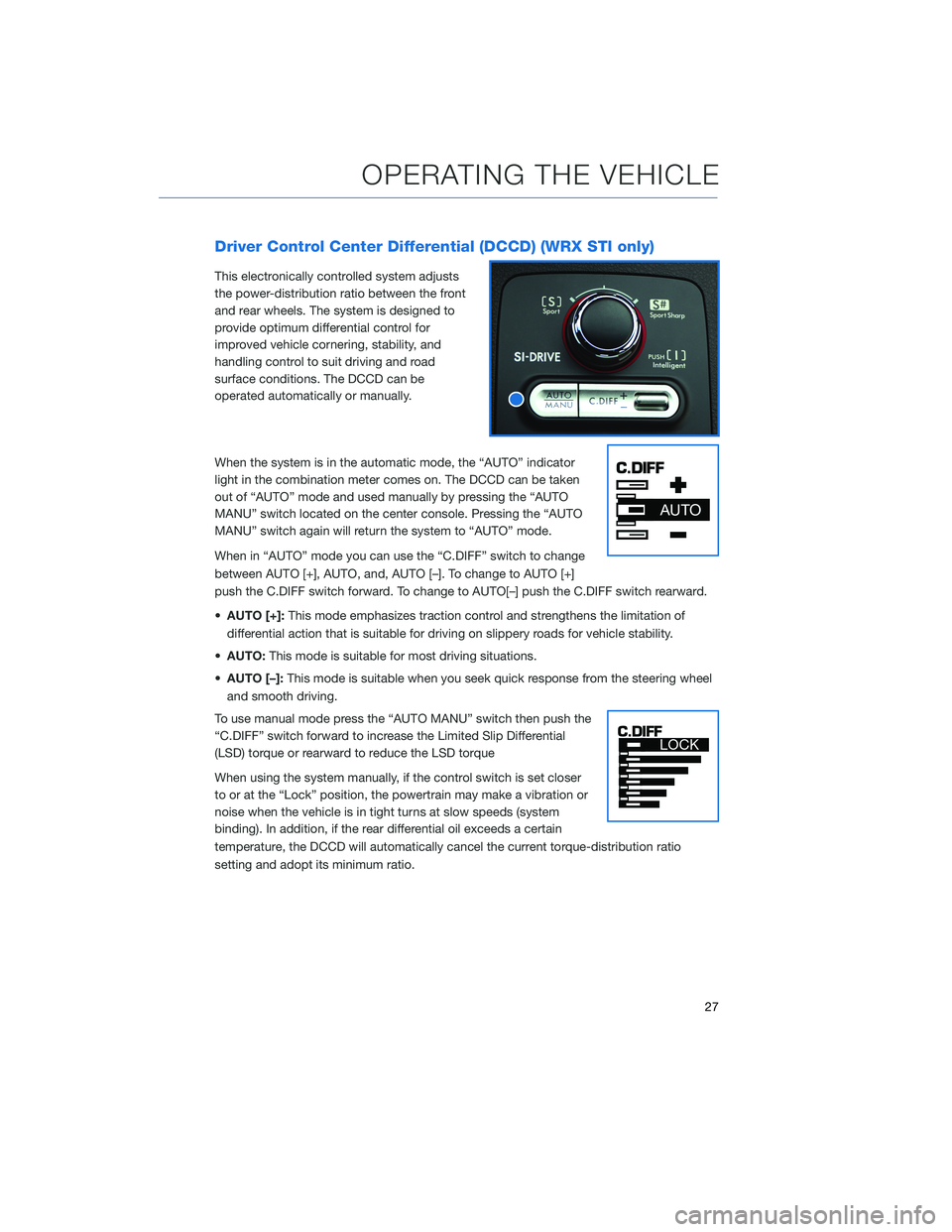
Driver Control Center Differential (DCCD) (WRX STI only)
This electronically controlled system adjusts
the power-distribution ratio between the front
and rear wheels. The system is designed to
provide optimum differential control for
improved vehicle cornering, stability, and
handling control to suit driving and road
surface conditions. The DCCD can be
operated automatically or manually.
When the system is in the automatic mode, the “AUTO” indicator
light in the combination meter comes on. The DCCD can be taken
out of “AUTO” mode and used manually by pressing the “AUTO
MANU” switch located on the center console. Pressing the “AUTO
MANU” switch again will return the system to “AUTO” mode.
When in “AUTO” mode you can use the “C.DIFF” switch to change
between AUTO [+], AUTO, and, AUTO [–]. To change to AUTO [+]
push the C.DIFF switch forward. To change to AUTO[–] push the C.DIFF switch rearward.
•AUTO [+]:This mode emphasizes traction control and strengthens the limitation of
differential action that is suitable for driving on slippery roads for vehicle stability.
•AUTO:This mode is suitable for most driving situations.
•AUTO [–]:This mode is suitable when you seek quick response from the steering wheel
and smooth driving.
To use manual mode press the “AUTO MANU” switch then push the
“C.DIFF” switch forward to increase the Limited Slip Differential
(LSD) torque or rearward to reduce the LSD torque
When using the system manually, if the control switch is set closer
to or at the “Lock” position, the powertrain may make a vibration or
noise when the vehicle is in tight turns at slow speeds (system
binding). In addition, if the rear differential oil exceeds a certain
temperature, the DCCD will automatically cancel the current torque-distribution ratio
setting and adopt its minimum ratio.
OPERATING THE VEHICLE
27
Page 30 of 44
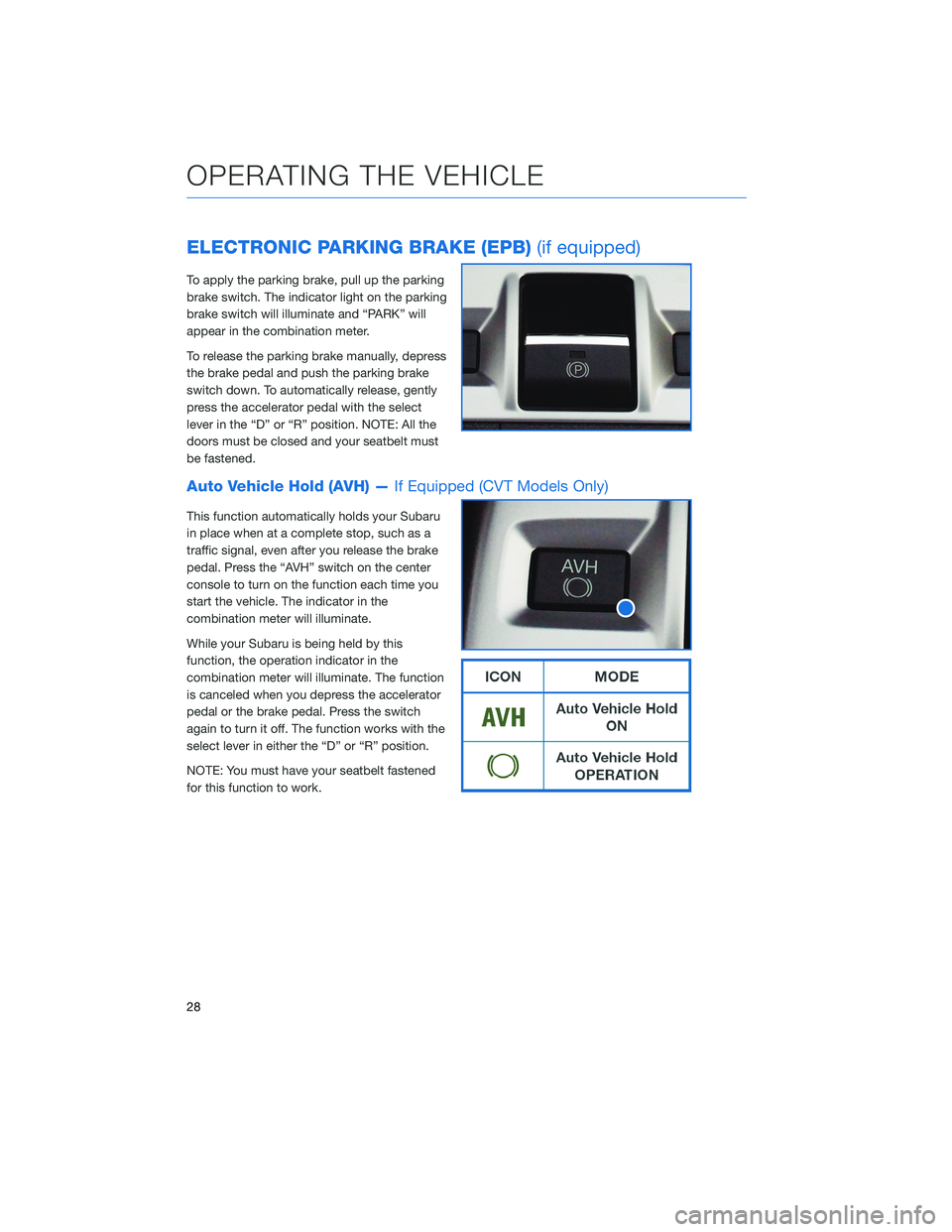
ELECTRONIC PARKING BRAKE (EPB)(if equipped)
To apply the parking brake, pull up the parking
brake switch. The indicator light on the parking
brake switch will illuminate and “PARK” will
appear in the combination meter.
To release the parking brake manually, depress
the brake pedal and push the parking brake
switch down. To automatically release, gently
press the accelerator pedal with the select
lever in the “D” or “R” position. NOTE: All the
doors must be closed and your seatbelt must
be fastened.
Auto Vehicle Hold (AVH) —If Equipped (CVT Models Only)
This function automatically holds your Subaru
in place when at a complete stop, such as a
traffic signal, even after you release the brake
pedal. Press the “AVH” switch on the center
console to turn on the function each time you
start the vehicle. The indicator in the
combination meter will illuminate.
While your Subaru is being held by this
function, the operation indicator in the
combination meter will illuminate. The function
is canceled when you depress the accelerator
pedal or the brake pedal. Press the switch
again to turn it off. The function works with the
select lever in either the “D” or “R” position.
NOTE: You must have your seatbelt fastened
for this function to work.
OPERATING THE VEHICLE
28